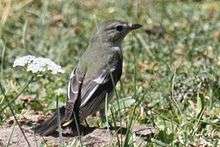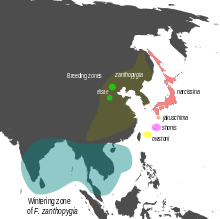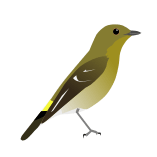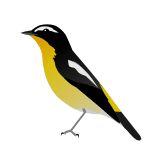Yellow-rumped flycatcher
The yellow-rumped flycatcher, Korean flycatcher or tricolor flycatcher (Ficedula zanthopygia) is a species of flycatcher found in eastern Asia. A distinctive species with almost no look-alike other than the narcissus flycatcher. It breeds in eastern Asia including parts of Mongolia, Transbaikal, southern China, Korea and western Japan. They winter in parts of the Malay Peninsula and South Asia.
| Yellow-rumped flycatcher | |
|---|---|
.jpg) | |
| Adult male | |
 | |
| Adult female (Mongolia) | |
| Scientific classification | |
| Kingdom: | Animalia |
| Phylum: | Chordata |
| Class: | Aves |
| Order: | Passeriformes |
| Family: | Muscicapidae |
| Genus: | Ficedula |
| Species: | F. zanthopygia |
| Binomial name | |
| Ficedula zanthopygia | |
 | |
| Breeding range in blue | |
| Synonyms | |
|
Xanthopygia tricolor (Hartlaub, 1845) | |
Identification


In all plumages the yellow rump is distinctive. The white supercilium of the male is distinctive, separating it from the narcissus flycatcher and the Chinese flycatcher. Females and first year males are olive grey above with blackish tail.[3] Hartert (1910) treated this as a part of the narcissina group.[4][5] Some individuals with yellow supercilium have been considered as hybrids with the narcissus flycatcher.[6] Included in this species complex was the species called Elise's flycatcher, usually treated as a subspecies of the narcissus flycatcher. Both elisae and zanthopygia have been observed to breed separately in the same area of oak forest near Peking strengthening the case for their distinctness.[7] There are also clear call and morphological difference between the two.[8][9] The genus Muscicapa has been noted to have been polyphyletic and is still in the process of being resolved[10] although the genus Ficedula is now considered monophyletic[11] with their origins in east Asia, with diversification following climate changes in the Pliocene.[12] Male have black upperparts with white supercilium and wingpatch, rich yellow underparts and rump. Female have greyish or olive-green above, paler below, with wingbar and yellow rump. May show yellow on throat.[13]
Ecology
| |||||||||||||||||||||||||||||||||||||||||||||||||||
| Relationships with other species |
The breeding area of the species is in Manchuria, Korea and China. The nesting in Xiaoxingan region is mainly in May and June. They breed mainly in low valleys at the base of hills. The home range of a pair can be about 2000-5000 sq. m. The nest is built in about three to four days by the female alone. The clutch is 4-7 eggs which are incubated by the female alone for about 11–12 days. The adults forage within about 70 metres (230 ft) of the nest to feed the chicks. The young fledge after 14–15 days.[14][15] It was first noted to winter in central India in 1989, it has since been found to winter in southwestern India and Sri Lanka.[16][17]
A species of ectoparasitic feather mite, Proterothrix megacaula was first discovered and described from the body of a yellow-rumped flycatcher in China.[18]
References
- BirdLife International (2012). "Ficedula zanthopygia". IUCN Red List of Threatened Species. 2012. Retrieved 26 November 2013.CS1 maint: ref=harv (link)
- Hay, Arthur (1845). "[untitled]". Madras Journal of Literature & Science. 13 (2): 162.
- Rasmussen, PC & JC Anderton (2005). Birds of South Asia: The Ripley Guide. 2. Smithsonian Institution and Lynx Edicions. p. 375.
- Hartert, E. (1910). Die Vögel der paläarktischen Fauna. 1. Friedlander und Sohn, Berlin. p. 490.
- Dekker, R.W.R.J.; E.C. Dickinson & Hiroyuki Morioka (2001). "Systematic notes on Asian birds. 18. Some nomenclatural issues relating to Japanese taxa described in the Planches Coloriées (1820-1839) and Fauna Japonica, Aves (1844-1850)" (PDF). Zool. Verh. Leiden. 335: 99–214.
- McCarthy, Eugene M (2006). Handbook of Avian Hybrids of the World. Oxford University Press US. p. 242. ISBN 0-19-518323-1.
- Weigold, H. (1922). "Muscicapa elisae n. sp". Falco. 18 (1): 1–2.
- Zhang, Y.-Y.; N. Wang; J. Zhang & G.-M. Zheng (2006). "Acoustic difference of narcissus flycatcher complex". Acta Zool. Sinica. 52 (4): 648–654.
- Töpfer, T. (2006). "Systematic notes on Asian birds. 60. Remarks on the systematic position of Ficedula elisae (Weigold, 1922)". Zool. Med. Leiden. 80–5 (12): 203–212.
- Lei Xin; Lian Zhen-Min; Lei Fu-Min; Yin Zuo-Hua; Zhao Hong-Feng (2007). "Phylogeny of some Muscicapinae birds based on cyt b mitochondrial gene sequences" (PDF). Acta Zoologica Sinica. 53 (1): 95.
- Outlaw DC, Voelker G (2006). "Systematics of Ficedula flycatchers (Muscicapidae): a molecular reassessment of a taxonomic enigma" (PDF). Mol Phylogenet Evol. 41 (1): 118–26. doi:10.1016/j.ympev.2006.05.004. PMID 16797192.
- Outlaw DC, Voelker G (2008). "Pliocene climatic change in insular Southeast Asia as an engine of diversification in Ficedula flycatchers". Journal of Biogeography. 35 (4): 739. doi:10.1111/j.1365-2699.2007.01821.x.
- Woo-Shin Lee, Tae-Hoe Koo, Jin-Young Park (2005). A field guide to the birds of Korea. p. 248. ISBN 978-8995141533.
- Liu, Y; Wang, J (1981). "Studies on the Breeding Behaviour of the Tricolar Flycatcher". Acta Zool. Sin. 27 (3): 287–291.
- Wang, N; Yanyun Zhang & Guangmei Zheng (2007). "Home ranges and habitat vegetation characters in breeding season of Narcissus Flycatcher and Yellow-rumped Flycatcher". Frontiers of Biology in China. 2 (3): 345–350. doi:10.1007/s11515-007-0051-1.
- Haribal, Meena (1992). "Yellow-rumped Flycatcher M. zanthopygia: a new addition to the avifauna of the Indian subcontinent". J. Bombay Nat. Hist. Soc. 88 (3): 456–458.
- Holt, Paul I. (2003). "Yellow-rumped flycatcher Ficedula zanthopygia in Kerala". J. Bombay Nat. Hist. Soc. 100 (1): 145.
- Mironov, S. V.; W. Diao; Y. Zhang; C. Zhang & Zh. Yan (2008). "A new feather mite species of the genus Proterothrix Gaud (Astigmatea, Proctophyllodidae) from Ficedula zanthopygia (Hay) (Passeriformes: Muscicapidae) in China". Acarina. 16 (1): 31–38.
